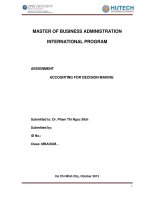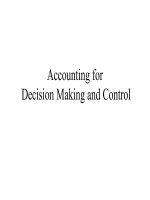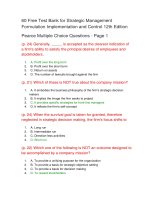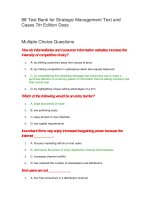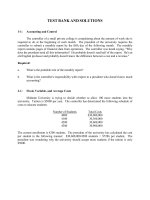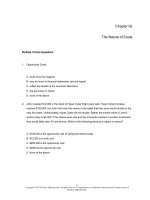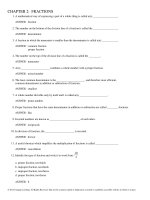Accounting for decision making and control 7th edition jim
Bạn đang xem bản rút gọn của tài liệu. Xem và tải ngay bản đầy đủ của tài liệu tại đây (3.91 MB, 717 trang )
zim36725_fm_i-xvi.qxd
12/15/09
2:31 PM
Page i
Seventh Edition
Accounting for
Decision Making
and Control
Jerold L. Zimmerman
University of Rochester
zim36725_fm_i-xvi.qxd
12/15/09
2:31 PM
Page ii
To: Conner, Easton, and Jillian
ACCOUNTING FOR DECISION MAKING AND CONTROL, SEVENTH EDITION
Published by McGraw-Hill, a business unit of The McGraw-Hill Companies, Inc., 1221 Avenue of the Americas,
New York, NY 10020. Copyright © 2011 by The McGraw-Hill Companies, Inc. All rights reserved. Previous
editions © 2009, 2006, and 2003. No part of this publication may be reproduced or distributed in any form or by
any means, or stored in a database or retrieval system, without the prior written consent of The McGraw-Hill
Companies, Inc., including, but not limited to, in any network or other electronic storage or transmission, or
broadcast for distance learning.
Some ancillaries, including electronic and print components, may not be available to customers outside the United States.
This book is printed on acid-free paper.
1 2 3 4 5 6 7 8 9 0 DOW/DOW 1 0 9 8 7 6 5 4 3 2 1 0
ISBN
MHID
978-0-07-813672-6
0-07-813672-5
Vice President & Editor-in-Chief: Brent Gordon
Vice President of EDP: Sesha Bolisetty
Editorial Director: Stewart Mattson
Sponsoring Editor: Dick Hercher
Marketing Manager: Sankha Basu
Editorial Coordinator: Rebecca Mann
Project Manager: Erin Melloy
Design Coordinator: Brenda A. Rolwes
Cover Designer: Studio Montage, St. Louis, Missouri
Production Supervisor: Sue Culbertson
Media Project Manager: Balaji Sundararaman
Compositor: MPS Limited, A Macmillan Company
Typeface: 10/12 Times New Roman
Printer: R. R. Donnelley-Willard
All credits appearing on page or at the end of the book are considered to be an extension of the copyright page.
Library of Congress Cataloging-in-Publication Data
Zimmerman, Jerold L., 1947Accounting for decision making and control / Jerold L. Zimmerman.—7th ed.
p. cm.
Includes bibliographical references and index.
ISBN-13: 978-0-07-813672-6 (acid-free paper)
ISBN-10: 0-07-813672-5 (acid-free paper) 1. Managerial accounting. I. Title.
HF5657.4.Z55 2010
658.15'11—dc22
2009049120
www.mhhe.com
zim36725_fm_i-xvi.qxd
12/15/09
2:31 PM
Page iii
About the Author
Jerold L. Zimmerman
Jerold Zimmerman is Ronald L. Bittner Professor at the
William E. Simon Graduate School of Business, University of Rochester. He holds an undergraduate degree from
the University of Colorado, Boulder, and a doctorate
from the University of California, Berkeley.
While at Rochester, Dr. Zimmerman has taught a variety of courses spanning accounting, finance, and economics. Accounting courses include nonprofit accounting,
intermediate accounting, accounting theory, and managerial accounting. A deeper appreciation of the challenges of
managing a complex organization was acquired by spending four years as Deputy Dean of the Simon School.
Professor Zimmerman publishes widely in accounting on topics as diverse as cost allocations, Sarbanes-Oxley Act, disclosure, financial accounting theory, capital markets, and
executive compensation. His paper “The Costs and Benefits of Cost Allocations” won the
American Accounting Association’s Competitive Manuscript Contest. He is recognized for
developing Positive Accounting Theory. This work, co-authored with colleague Ross Watts,
at the Massachusetts Institute of Technology, received the American Institute of Certified
Public Accountants’ Notable Contribution to the Accounting Literature Award for “Towards
a Positive Theory of the Determination of Accounting Standards” and “The Demand for
and Supply of Accounting Theories: The Market for Excuses.” Both papers appeared in the
Accounting Review. Professors Watts and Zimmerman are also co-authors of the highly
cited textbook Positive Accounting Theory (Prentice Hall, 1986). More recently, Professors
Watts and Zimmerman received the 2004 American Accounting Association Seminal Contribution to the Literature award. Professor Zimmerman’s textbooks also include: Managerial Economics and Organizational Architecture with Clifford Smith and James Brickley,
5th ed. (McGraw-Hill/Irwin, 2009); and Management Accounting: Analysis and Interpretation with Cheryl McWatters and Dale Morse (Pearson Education Limited UK, 2008). He is
a founding editor of the Journal of Accounting and Economics, published by North-Holland.
This scientific journal is one of the most highly referenced accounting publications.
He and his wife Dodie have two daughters, Daneille and Amy. Jerry has been known
to occasionally engage friends and colleagues in an amicable diversion on the links.
iii
zim36725_fm_i-xvi.qxd
12/15/09
2:31 PM
Page iv
Preface
During their professional careers, managers in all organizations, profit and nonprofit, interact with their accounting systems. Sometimes managers use the accounting system to acquire information for decision making. At other times, the accounting system measures
performance and thereby influences their behavior. The accounting system is both a source
of information for decision making and part of the organization’s control mechanisms—
thus, the title of the book, Accounting for Decision Making and Control.
The purpose of this book is to provide students and managers with an understanding and
appreciation of the strengths and limitations of an organization’s accounting system, thereby
allowing them to be more intelligent users of these systems. This book provides a framework
for thinking about accounting systems and a basis for analyzing proposed changes to these
systems. The text demonstrates that managerial accounting is an integral part of the firm’s
organizational architecture, not just an isolated set of computational topics.
Distinguishing Features
Conceptual
Framework
This book differs from other managerial accounting texts in several ways. The most important
difference is that it offers a conceptual framework for the study of managerial accounting.
This book relies on opportunity cost and organizational architecture as the underlying
framework to organize the analysis. Opportunity cost is the conceptual foundation underlying
decision making. While accounting-based costs are not opportunity costs, in some circumstances accounting costs provide a starting point to estimate opportunity costs. Organizational
architecture provides the conceptual foundation to understand how accounting is employed as
part of the organization’s control mechanism. These two concepts, opportunity costs and
organizational architecture, provide the framework and illustrate the trade-offs created when
accounting systems serve both functions: decision making and control.
Trade-Offs
This text emphasizes that there is no “free lunch”; improving an accounting system’s
decision-making ability often reduces its effectiveness as a control device. Likewise, using
an accounting system as a control mechanism usually comes at the expense of using the
system for decision making. Most texts discuss the importance of deriving different estimates of costs for different purposes. Existing books do a good job illustrating how
accounting costs developed for one purpose, such as inventory valuation, cannot be used
without adjustment for other purposes, such as a make-or-buy decision. However, these
books often leave the impression that one accounting system can be used for multiple
purposes as long as the users make the appropriate adjustments in the data.
What existing texts do not emphasize is the trade-off between designing the accounting system for decision making and designing it for control. For example, activity-based
costing presumably improves the accounting system’s ability for decision making (pricing
and product design), but existing texts do not address what activity-based costing gives up
in terms of control. Accounting for Decision Making and Control emphasizes the trade-offs
managers confront in an organization’s accounting system.
iv
zim36725_fm_i-xvi.qxd
12/15/09
2:31 PM
Page v
Preface
v
Economic
Darwinism
A central theme throughout this book is economic Darwinism, which simply implies that
accounting systems that survive in competitive industries must be yielding benefits that are
at least as large as their costs. While newer accounting innovations such as the balanced
scorecard are described, the text also indicates through a series of company histories that
many elements of today’s modern costing systems can be traced back to much earlier times.
It is useful to understand that today’s managers are struggling with the same accounting issues as their predecessors, because today’s students will also be struggling with the same
problems. These problems continue to exist because they involve making trade-offs, usually between systems for decision making (e.g., product pricing and make-or-buy decisions) versus control (e.g., performance evaluation).
Accounting systems differ across firms and change as firms’ circumstances change.
Today’s students will be making these trade-offs in the future. The current rage in managerial accounting texts is to present the latest, most up-to-date accounting system innovations.
While recent innovations are important to discuss, they should be placed in their proper
perspective. Traditional absorption costing systems have survived the test of time for hundreds of years. Accounting system innovations are new, not necessarily better. We certainly
do not know if they will survive.
Logical Sequence
Another meaningful distinction between this text and other books in the field is that the
chapters in this text build on one another. The first four chapters develop the opportunity
cost and organization theory foundation for the course. The remaining chapters apply the
foundation to analyzing specific topics such as budgets and standard costs. Most of the
controversy in product costing involves apportioning overhead. Before absorption, variable,
and activity-based costing are described, an earlier chapter provides a general analysis of
cost allocation. This analysis is applied in later chapters as the analytic framework for
choosing among the various product costing schemes. Other books emphasize a modular,
flexible approach that allows instructors to devise their own sequence to the material, with
the result that these courses often appear as a series of unrelated, disjointed topics without
any underlying cohesive framework. This book has 14 chapters, compared with the usual
18–25. Instead of dividing a topic such as cost allocation into three small chapters, most
topics are covered in one or at most two unified chapters.
End-of-Chapter
Material
The end-of-chapter problem material is an integral part of any text, and especially important in Accounting for Decision Making and Control. The problems and cases are drawn
from actual company applications described by former students based on their work experience. Many problems require students to develop critical thinking skills and to write short
essays after preparing their numerical analyses. Good problems get students excited about
the material and generate lively class discussions. Some problems do not have a single correct answer. Rather, they contain multiple dimensions demanding a broad managerial perspective. Marketing, finance, and human resource aspects of the situation are frequently
posed. Few problems focus exclusively on computations.
Changes in the Seventh Edition
Based on extensive feedback from instructors using the six editions and from my own
teaching experience, the seventh edition focuses on improving the book’s readability and
accessibility. In particular, the following changes have been made:
• Each chapter has been updated and streamlined based on student and instructor
feedback. More intuitive, easier-to-understand numerical examples have been
added.
zim36725_fm_i-xvi.qxd
vi
12/15/09
2:31 PM
Page vi
Preface
• Additional actual company practices have been integrated into the text.
• Sixteen new problems and cases supplement the existing problems. Users were
uniform in their praise of the problem material. They found it challenged their students
to critically analyze multidimensional issues while still requiring numerical problemsolving skills. Further problems and cases to complement this selection have been
added.
Overview of Content
Chapter 1 presents the book’s conceptual framework by using a simple decision context regarding accepting an incremental order from a current customer. The chapter describes why
firms use a single accounting system and the concept of economic Darwinism, among other
important topics. This chapter is an integral part of the text.
Chapters 2, 4, and 5 present the underlying conceptual framework. The importance of
opportunity costs in decision making, cost–volume–profit analysis, and the difference between accounting costs and opportunity costs are discussed in Chapter 2. Chapter 4 summarizes recent advances in the theory of organizations and Chapter 5 describes the crucial
role of accounting as part of the firm’s organizational architecture. Chapter 3 on capital
budgeting extends opportunity costs to a multiperiod setting. This chapter can be skipped
without affecting the flow of later material. Alternatively, Chapter 3 can be assigned at the
end of the course.
Chapter 6 applies the conceptual framework and illustrates the trade-off managers
must make between decision making and control in a budgeting system. Budgets are a
decision-making tool to coordinate activities within the firm and are a device to control
behavior. This chapter provides an in-depth illustration of how budgets are a significant
part of an organization’s decision-making and control apparatus.
Chapter 7 presents a general analysis of why managers allocate certain costs and the
behavioral implications of these allocations. Cost allocations affect both decision making
and incentives. Thus, there is again the trade-off between decision making and control.
Chapter 8 continues the cost allocation discussion by describing the “death spiral” that can
occur when significant fixed costs exist and excess capacity arises. This leads to an analysis of how to treat capacity costs—a trade-off between underutilization and overinvestment.
Finally, several specific cost allocation methods such as service department costs and joint
costs are described.
Chapter 9 applies the general analysis of overhead allocation in Chapters 7 and 8 to the
specific case of absorption costing in a manufacturing setting. The managerial implications
of traditional absorption costing are provided in Chapters 10 and 11. Chapter 10 analyzes
variable costing, and activity-based costing is the topic of Chapter 11. Variable costing is an
interesting example of economic Darwinism. Proponents of variable costing argue that it
does not distort decision making and therefore should be adopted. Nonetheless it is not
widely practiced, probably because of tax, financial reporting, and control considerations.
Chapter 12 discusses the decision-making and control implications of standard labor
and material costs. Chapter 13 extends the discussion to overhead and marketing variances. Chapter 13 can be omitted without interrupting the flow of later material. Finally,
Chapter 14 synthesizes the course by reviewing the conceptual framework and applying it
to recent organizational innovations, such as Six Sigma, lean production, and the balanced
scorecard. These innovations provide an opportunity to apply the analytic framework underlying the text.
zim36725_fm_i-xvi.qxd
12/15/09
2:31 PM
Page vii
vii
Preface
Overview of Table of Contents
Chapter 1
Introduction
Chapter 4
Organizational Architecture
Chapter 2
The Nature of Costs
Chapter 5
Responsibility Accounting
& Transfer Pricing
Chapter 3*
Opportunity Cost of
Capital and Capital Budgeting
Chapter 6
Budgeting
Chapter 7
Cost Allocation: Theory
Chapter 8
Cost Allocation: Practices
Chapter 9
Absorption Cost Systems
Chapter 10
Criticisms of Absorption Cost Systems: Incentive to Overproduce
Chapter 11
Criticisms of Absorption Cost Systems: Inaccurate Product Costs
Chapter 12
Standard Costs: Direct Labor and Materials
Chapter 13*
Overhead & Marketing Variances
Chapter 14
Management Accounting in a
Changing Environment
*Chapter can be omitted without interrupting the flow of material.
zim36725_fm_i-xvi.qxd
12/15/09
viii
2:31 PM
Page viii
Preface
Using the Text
This book assumes that the student is familiar with introductory financial accounting.
Accounting for Decision Making and Control can be used in advanced undergraduate, graduate, or executive programs. It is being used widely outside the United States. While the
book relies on opportunity costs and organizational economics, much of the discussion is
at an intuitive level. To focus on the managerial implications of the material, journal entries
are deliberately de-emphasized.
The text is concise, which allows the instructor to supplement the course with additional
outside readings or heavy problem assignments. The text has been used in a 10-week quarter course with few outside readings and two to three hours of homework assignments for
every class period. MBA students find this challenging and rewarding. They report a better
understanding of how to use accounting numbers, are more comfortable at preparing financial analyses, and are better able to take a set of facts and communicate a cogent analysis.
Alternatively, the text can support a semester-length course. Executive MBA students praise
the text’s real-world applicability, readability, and the relevance of the problem material.
Some of the more challenging material is presented in appendixes following the chapters. Chapter 2’s appendix describes the pricing decision. Chapter 6’s appendix contains a
comprehensive master budget. The reciprocal method for allocating service department
costs is described in the appendix to Chapter 8. The appendixes to Chapter 9 describe
process costing and demand shifts, fixed costs, and pricing. Appendixes can be deleted
without affecting future chapter discussions.
Supplements
Online Learning Center (OLC): www.mhhe.com/zimerman7e.
The Instructor Edition of Accounting for Decision Making and Control, 7e, OLC is password protected and a convenient place for instructors to access course supplements. Resources for professors include chapter-by-chapter teaching strategies, suggested problem
assignments, recommended outside cases, lecture notes, sample syllabi, chapter PowerPoint
presentations, and complete solutions to all problems and case material within the text.
The Student Edition of Accounting for Decision Making and Control, 7e, OLC
contains review material to help students study, including PowerPoint presentations and
multiple-choice quizzes.
Tegrity Campus: Lectures 24/7
Tegrity Campus is a service that makes
class time available 24/7 by automatically capturing lectures in a searchable format for students to review when they study and complete assignments. With a simple one-click startand-stop process, you capture all computer screens and corresponding audio. Students can
replay any part of any class with easy-to-use browser-based viewing. With Tegrity Campus,
students quickly recall key moments by using Tegrity Campus’s unique search feature.
To learn more about Tegrity, watch a two-minute Flash demo at http://tegritycampus
.mhhe.com.
Acknowledgments
William Vatter and George Benston motivated my interest in managerial accounting. The
genesis for this book and its approach reflect the oral tradition of my colleagues, past and
present, at the University of Rochester. William Meckling and Michael Jensen stimulated
my thinking and provided much of the theoretical structure underlying the book, as anyone
familiar with their work will attest. My long and productive collaboration with Ross Watts
sharpened my analytical skills and further refined the approach. He also furnished most of
the intellectual capital for Chapter 3, including the problem material. Ray Ball has been a
zim36725_fm_i-xvi.qxd
12/15/09
2:31 PM
Page ix
ix
Preface
constant source of ideas. Clifford Smith and James Brickley continue to enhance my economic education. Three colleagues, Andrew Christie, Dan Gode, and Scott Keating, supplied particularly insightful comments that enriched the analysis at critical junctions.
Valuable comments from Anil Arya, Ron Dye, Andy Leone, K. Ramesh, Shyam Sunder,
and Joseph Weintrop are gratefully acknowledged.
This project benefited greatly from the honest and intelligent feedback of numerous
instructors. I wish to thank Mahendra Gupta, Susan Hamlen, Badr Ismail, Charles Kile,
Leslie Kren, Don May, William Mister, Mohamed Onsi, Ram Ramanan, Stephen Ryan,
Michael Sandretto, Richard Sansing, Deniz Saral, Gary Schneider, Joe Weber, and William
Yancey. This book also benefited from two other projects with which I have been involved.
Writing Managerial Economics and Organizational Architecture (McGraw-Hill/Irwin,
2009) with James Brickley and Clifford Smith and Management Accounting: Analysis and
Interpretation (Pearson Education, Limited (UK), 2008) with Cheryl McWatters and Dale
Morse helped me to better understand how to present certain topics.
To the numerous students who endured the development process, I owe an enormous
debt of gratitude. I hope they learned as much from the material as I learned teaching them.
Some were even kind enough to provide critiques and suggestions, in particular Jan Dick
Eijkelboom. Others supplied, either directly or indirectly, the problem material in the text.
The able research assistance of P. K. Madappa, Eamon Molloy, Jodi Parker, Steve Sanders,
Richard Sloan, and especially Gary Hurst, contributed amply to the manuscript and problem material. Janice Willett and Barbara Schnathorst did a superb job of editing the manuscript and problem material.
The very useful comments and suggestions from the following reviewers are greatly
appreciated:
Urton Anderson
Howard M. Armitage
Vidya Awasthi
Kashi Balachandran
Da-Hsien Bao
Ron Barden
Howard G. Berline
Margaret Boldt
David Borst
Eric Bostwick
Marvin L. Bouillon
Wayne Bremser
David Bukovinsky
Linda Campbell
William M. Cready
James M. Emig
Gary Fane
Anita Feller
Tahirih Foroughi
Ivar Fris
Jackson F. Gillespie
Irving Gleim
Jon Glover
Gus Gordon
Sylwia Gornik-Tomaszewski
Susan Haka
Bert Horwitz
Steven Huddart
Robert Hurt
Douglas A. Johnson
Lawrence A. Klein
Thomas Krissek
A. Ronald Kucic
Daniel Law
Chi-Wen Jevons Lee
Suzanne Lowensohn
James R. Martin
Alan H. McNamee
Marilyn Okleshen
Shailandra Pandit
Sam Phillips
Frank Probst
Kamala Raghavan
Ram Ramanan
William Rau
Jane Reimers
Thomas Ross
Harold P. Roth
P. N. Saksena
Donald Samaleson
Michael J. Sandretto
Arnold Schneider
Henry Schwarzbach
Elizabeth J. Serapin
Norman Shultz
James C. Stallman
William Thomas Stevens
Monte R. Swain
Clark Wheatley
Lourdes F. White
Paul F. Williams
Robert W. Williamson
Jeffrey A. Yost
S. Mark Young
zim36725_fm_i-xvi.qxd
x
12/15/09
2:31 PM
Page x
Preface
Kathy Jones, my very able assistant, had the difficult and often impossible task of
managing and editing the manuscript and instructor manual. She did a superb job. To my
wife Dodie and daughters Daneille and Amy, thank you for setting the right priorities and
for giving me the encouragement and environment to be productive. Finally, I wish to thank
my parents for all their support.
Jerold L. Zimmerman
University of Rochester
zim36725_fm_i-xvi.qxd
12/15/09
2:31 PM
Page xi
Brief Contents
1
Introduction 1
2
The Nature of Costs 22
3
Opportunity Cost of Capital and Capital Budgeting 89
4
Organizational Architecture 135
5
Responsibility Accounting and Transfer Pricing 170
6
Budgeting 229
7
Cost Allocation: Theory 302
8
Cost Allocation: Practices 347
9
Absorption Cost Systems 409
10
Criticisms of Absorption Cost Systems: Incentive to Overproduce 468
11
Criticisms of Absorption Cost Systems: Inaccurate Product Costs 501
12
Standard Costs: Direct Labor and Materials 554
13
Overhead and Marketing Variances 592
14
Management Accounting in a Changing Environment 627
Solutions to Concept Questions
Glossary 684
Index 693
674
xi
zim36725_fm_i-xvi.qxd
12/16/09
8:30 PM
Page xii
Contents
1
Introduction 1
A.
B.
C.
D.
E.
F.
G.
H.
2
Managerial Accounting: Decision Making and Control 2
Design and Use of Cost Systems 4
Marmots and Grizzly Bears 8
Management Accountant’s Role in the Organization 10
Evolution of Management Accounting: A Framework for Change 13
Vortec Medical Probe Example 15
Outline of the Text 18
Summary 19
The Nature of Costs 22
A. Opportunity Costs 23
1. Characteristics of Opportunity Costs 24
2. Examples of Decisions Based on Opportunity Costs 24
B. Cost Variation 28
1. Fixed, Marginal, and Average Costs 28
2. Linear Approximations 31
3. Other Cost Behavior Patterns 32
4. Activity Measures 33
C. Cost–Volume–Profit Analysis 34
1. Copier Example 34
2. Calculating Break-Even and Target Profits 36
3. Limitations of Cost–Volume–Profit Analysis 40
4. Multiple Products 40
5. Operating Leverage 42
D. Opportunity Costs versus Accounting Costs 45
1. Period versus Product Costs 46
2. Direct Costs, Overhead Costs, and Opportunity Costs 46
E. Cost Estimation 50
1. Account Classification 50
2. Motion and Time Studies 50
F. Summary 50
Appendix: Costs and the Pricing Decision 51
3
Opportunity Cost of Capital and Capital Budgeting 89
A. Opportunity Cost of Capital 90
B. Interest Rate Fundamentals 93
1. Future Values 93
2. Present Values 94
xii
zim36725_fm_i-xvi.qxd
12/15/09
2:31 PM
Page xiii
xiii
Contents
C.
D.
E.
F.
4
3. Present Value of a Cash Flow Stream 95
4. Perpetuities 96
5. Annuities 97
6. Multiple Cash Flows per Year 98
Capital Budgeting: The Basics 100
1. Decision to Acquire an MBA 100
2. Decision to Open a Video Rental Store 101
3. Essential Points about Capital Budgeting 102
Capital Budgeting: Some Complexities 104
1. Risk 104
2. Inflation 105
3. Taxes and Depreciation Tax Shields 107
Alternative Investment Criteria 109
1. Payback 109
2. Accounting Rate of Return 109
3. Internal Rate of Return (IRR) 111
4. Methods Used in Practice 114
Summary 115
Organizational Architecture 135
A. Basic Building Blocks 136
1. Self-Interested Behavior, Team Production,
and Agency Costs 136
2. Decision Rights and Rights Systems 142
3. Role of Knowledge and Decision Making 142
4. Markets versus Firms 143
5. Influence Costs 145
B. Organizational Architecture 146
1. Three-Legged Stool 147
2. Decision Management versus Decision Control 150
C. Accounting’s Role in the Organization’s Architecture 152
D. Example of Accounting’s Role: Executive
Compensation Contracts 155
E. Summary 157
5
Responsibility Accounting and Transfer Pricing 170
A. Responsibility Accounting 171
1. Cost Centers 171
2. Profit Centers 174
3. Investment Centers 175
4. Economic Value Added (EVA®) 180
5. Controllability Principle 183
B. Transfer Pricing 185
1. International Taxation 185
2. Economics of Transfer Pricing 187
3. Common Transfer Pricing Methods 191
4. Reorganization: The Solution If All Else Fails 197
5. Recap 197
C. Summary 199
zim36725_fm_i-xvi.qxd
xiv
12/15/09
2:31 PM
Page xiv
Contents
6
Budgeting 229
A. Generic Budgeting Systems 231
1. Country Club 231
2. Private University 236
3. Large Corporation 238
B. Trade-Off between Decision Management
and Decision Control 241
1. Communicating Specialized Knowledge versus
Performance Evaluation 242
2. Budget Ratcheting 242
3. Participative Budgeting 245
4. New Approaches to Budgeting 246
5. Managing the Trade-Off 249
C. Resolving Organizational Problems 249
1. Short-Run versus Long-Run Budgets 250
2. Line-Item Budgets 252
3. Budget Lapsing 253
4. Static versus Flexible Budgets 253
5. Incremental versus Zero-Based Budgets 257
D. Summary 258
Appendix: Comprehensive Master Budget Illustration 259
7
Cost Allocation: Theory 302
A. Pervasiveness of Cost Allocations 304
1. Manufacturing Organizations 305
2. Hospitals 306
3. Universities 306
B. Reasons to Allocate Costs 308
1. External Reporting/Taxes 308
2. Cost-Based Reimbursement 309
3. Decision Making and Control 311
C. Incentive/Organizational Reasons for
Cost Allocations 312
1. Cost Allocations Are a Tax System 312
2. Taxing an Externality 313
3. Insulating versus Noninsulating Cost Allocations 319
D. Summary 322
8
Cost Allocation: Practices 347
A. Death Spiral 348
B. Allocating Capacity Costs: Depreciation 353
C. Allocating Service Department Costs 353
1. Direct Allocation Method 355
2. Step-Down Allocation Method 357
3. Service Department Costs and Transfer Pricing of Direct
and Step-Down Methods 359
4. Reciprocal Allocation Method 362
5. Recap 364
zim36725_fm_i-xvi.qxd
12/15/09
2:31 PM
Page xv
Contents
xv
D. Joint Costs 364
1. Chickens 366
2. Net Realizable Value 367
3. Decision Making and Control 371
E. Segment Reporting and Joint Benefits 372
F. Summary 373
Appendix: Reciprocal Method for Allocating Service Department Costs 374
9
Absorption Cost Systems 409
A. Job Order Costing 411
B. Cost Flows through the T-Accounts 413
C. Allocating Overhead to Jobs 416
1. Overhead Rates 416
2. Over/Underabsorbed Overhead 417
3. Flexible Budgets to Estimate Overhead 420
4. Expected versus Normal Volume 423
D. Permanent versus Temporary Volume Changes 427
E. Plantwide versus Multiple Overhead Rates 428
F. Process Costing: The Extent of Averaging 432
G. Summary 433
Appendix A: Process Costing 433
Appendix B: Demand Shifts, Fixed Costs, and Pricing 439
10
Criticisms of Absorption Cost Systems: Incentive to Overproduce 468
A. Incentive to Overproduce 470
1. Example 470
2. Reducing the Overproduction Incentive 472
B. Variable (Direct) Costing 474
1. Background 474
2. Illustration of Variable Costing 474
3. Overproduction Incentive under Variable
Costing 477
C. Problems with Variable Costing 478
1. Classifying Fixed Costs as Variable Costs 478
2. Ignores Opportunity Cost of Capacity 480
D. Beware of Unit Costs 481
E. Summary 483
11
Criticisms of Absorption Cost Systems: Inaccurate Product Costs 501
A. Inaccurate Product Costs 502
B. Activity-Based Costing 506
1. Choosing Cost Drivers 507
2. Absorption versus Activity-Based Costing: An Example 513
C. Analyzing Activity-Based Costing 517
1. Reasons for Implementing Activity-Based Costing 517
2. Benefits and Costs of Activity-Based Costing 519
3. ABC Measures Costs, Not Benefits 521
D. Acceptance of Activity-Based Costing 523
E. Summary 527
zim36725_fm_i-xvi.qxd
xvi
12/15/09
2:31 PM
Page xvi
Contents
12
Standard Costs: Direct Labor and Materials 554
A. Standard Costs 555
1. Reasons for Standard Costing 556
2. Setting and Revising Standards 557
3. Target Costing 561
B. Direct Labor and Materials Variances 562
1. Direct Labor Variances 563
2. Direct Materials Variances 567
3. Risk Reduction and Standard Costs 571
C. Incentive Effects of Direct Labor and Materials Variances 571
1. Build Inventories 572
2. Externalities 572
3. Discouraging Cooperation 573
4. Mutual Monitoring 573
5. Satisficing 573
D. Disposition of Standard Cost Variances 574
E. The Costs of Standard Costs 576
F. Summary 578
13
Overhead and Marketing Variances 592
A. Budgeted, Standard, and Actual Volume 593
B. Overhead Variances 596
1. Flexible Overhead Budget 596
2. Overhead Rate 597
3. Overhead Absorbed 598
4. Overhead Efficiency, Volume, and Spending Variances 599
5. Graphical Analysis 602
6. Inaccurate Flexible Overhead Budget 604
C. Marketing Variances 605
1. Price and Quantity Variances 605
2. Mix and Sales Variances 606
D. Summary 608
14
Management Accounting in a Changing Environment 627
A. Integrative Framework 628
1. Organizational Architecture 629
2. Business Strategy 630
3. Environmental and Competitive Forces Affecting Organizations 633
4. Implications 633
B. Organizational Innovations and Management Accounting 634
1. Total Quality Management (TQM) 635
2. Just-in-Time (JIT) Production 639
3. Six Sigma and Lean Production 642
4. Balanced Scorecard 644
C. When Should the Internal Accounting System Be Changed? 650
D. Summary 651
Solutions to Concept Questions 674
Glossary 684
Index 693
zim36725_ch01_001-021.qxd
12/15/09
11:24 AM
Page 1
Chapter One
Introduction
Chapter Outline
A. Managerial Accounting: Decision Making
and Control
B. Design and Use of Cost Systems
C. Marmots and Grizzly Bears
D. Management Accountant’s Role in the
Organization
E. Evolution of Management Accounting:
A Framework for Change
F. Vortec Medical Probe Example
G. Outline of the Text
H. Summary
1
zim36725_ch01_001-021.qxd
2
12/15/09
11:24 AM
Page 2
Chapter 1
A. Managerial Accounting: Decision Making and Control
Managers at BMW must decide which car models to produce, the quantity of each model
to produce given the selling prices for the models, and how to manufacture the automobiles. They must decide which car parts, such as headlight assemblies, BMW should manufacture internally and which parts should be outsourced. They must decide not only on
advertising, distribution, and product positioning to sell the cars, but also the quantity and
quality of the various inputs to use. For example, they must determine which models will
have leather seats and the quality of the leather to be used.
How are future revenues and costs of proposed car models estimated? Similarly, in deciding which investment projects to accept, capital budgeting analysts require data on future cash flows. How are these numbers derived? How does one coordinate the activities of
hundreds or thousands of employees in the firm so that these employees accept senior management’s leadership? At BMW and organizations small and large, managers must have
good information to make all these decisions and the leadership abilities to get others to
implement the decisions.
Information about firms’ future costs and revenues is not readily available but must be
estimated by managers. Organizations must obtain and disseminate the knowledge to make
these decisions. Decision making is much easier with the requisite knowledge.
Organizations’ internal information systems provide some of the knowledge for these
pricing, production, capital budgeting, and marketing decisions. These systems range from
the informal and the rudimentary to very sophisticated, computerized management information systems. The term information system should not be interpreted to mean a single,
integrated system. Most information systems consist not only of formal, organized, tangible records such as payroll and purchasing documents but also informal, intangible bits of
data such as memos, special studies, and managers’ impressions and opinions. The firm’s
information system also contains nonfinancial information such as customer and employee
satisfaction surveys. As firms grow from single proprietorships to large global corporations
with tens of thousands of employees, managers lose the knowledge of enterprise affairs
gained from personal, face-to-face contact in daily operations. Higher-level managers of
larger firms come to rely more and more on formal operating reports.
The internal accounting system, an important component of a firm’s information system, includes budgets, data on the costs of each product and current inventory, and periodic
financial reports. In many cases, especially in small companies, these accounting reports
are the only formalized part of the information system providing the knowledge for decision making. Many larger companies have other formalized, nonaccounting–based information systems, such as production planning systems. This book focuses on how internal
accounting systems provide knowledge for decision making.
After making decisions, managers must implement them in organizations in which
the interests of the employees and the owners do not necessarily coincide. Just because
senior managers announce a decision does not necessarily ensure that the decision will be
implemented.
Organizations do not have objectives; people do. A discussion of an organization’s
objectives requires addressing the owners’ objectives. One common objective of owners is
to maximize profits, or the difference between revenues and expenses. Maximizing firm
value is equivalent to maximizing the stream of profits over the organization’s life. Employees, suppliers, and customers also have their own objectives—usually maximizing their
self-interest.
Not all owners care only about monetary flows. An owner of a professional sports team
might care more about winning (subject to covering costs) than maximizing profits.
zim36725_ch01_001-021.qxd
12/15/09
11:24 AM
Introduction
Page 3
3
Nonprofits do not have owners with the legal rights to the organization’s profits. Moreover, nonprofits seek to maximize their value by serving some social goal such as education, health care, or welfare.
No matter what the firm’s objective, the organization will survive only if its inflow of
resources (such as revenue) is at least as large as the outflow. Accounting information is
useful to help manage the inflow and outflow of resources and to help align the owners’ and
employees’ interests, no matter what objectives the owners wish to pursue.
Throughout this book, we assume that individuals maximize their self-interest. The
owners of the firm usually want to maximize profits, but managers and employees will do
so only if it is in their interest. Hence, a conflict of interest exists between owners—who, in
general, want higher profits—and employees—who want easier jobs, higher wages, and
more fringe benefits. To control this conflict, senior managers and owners design systems
to monitor employees’ behavior and incentive schemes that reward employees for generating
more profits. Not-for-profit organizations face similar conflicts. Those people responsible
for the nonprofit organization (boards of trustees and government officials) must design
incentive schemes to motivate their employees to operate the organization efficiently.
All successful firms must devise mechanisms that help align employee interests with
maximizing the organization’s value. All of these mechanisms constitute the firm’s control
system; they include performance measures and incentive compensation systems, promotions, demotions, and terminations, security guards and video surveillance, internal auditors,
and the firm’s internal accounting system.1
As part of the firm’s control system, the internal accounting system helps align the interests of managers and shareholders to cause employees to maximize firm value. It sounds
like a relatively easy task to design systems to ensure that employees maximize firm value.
But a significant portion of this book demonstrates the exceedingly complex nature of
aligning employee interests with those of the owners.
Internal accounting systems serve two purposes: (1) to provide some of the knowledge
necessary for planning and making decisions (decision making) and (2) to help motivate and
monitor people in organizations (control). The most basic control use of accounting is to prevent fraud and embezzlement. Maintaining inventory records helps reduce employee theft.
Accounting budgets, discussed more fully in Chapter 6, provide an example of both decision
making and control. Asking each salesperson in the firm to forecast their next year’s sales is
useful for planning next year’s production (decision making). However, if the salesperson’s
sales forecast is used to benchmark their performance for compensation purposes (control),
they have strong incentives to underestimate their budget forecasts.
Using internal accounting systems for both decision making and control gives rise to
the fundamental trade-off in these systems: A system cannot be designed to perform two
tasks as well as a system that must perform only one task. Some ability to deliver knowledge for decision making is usually sacrificed to provide better motivation (control). The
trade-off between providing knowledge for decision making and motivation/control arises
continually throughout this text.
This book is applications oriented: It describes how the accounting system assembles
knowledge necessary for implementing decisions using the theories from microeconomics,
Control refers to the process that helps “ensure the proper behaviors of the people in the organization.
These behaviors should be consistent with the organization’s strategy,” as noted in K Merchant, Control in
Business Organizations (Boston: Pitman Publishing Inc., 1985), p. 4. Merchant provides an extensive discussion
of control systems and a bibliography. In Theory of Accounting and Control (Cincinnati, OH: South-Western
Publishing Company, 1997), S Sunder describes control as mitigating and resolving conflicts between
employees, owners, suppliers, and customers that threaten to pull organizations apart.
1
zim36725_ch01_001-021.qxd
4
12/15/09
11:24 AM
Page 4
Chapter 1
finance, operations management, and marketing. It also shows how the accounting system
helps motivate employees to implement these decisions. Moreover, it stresses the continual trade-offs that must be made between the decision making and control functions of
accounting.
A survey of 2,000 senior-level executives (chief financial officers, vice presidents of
finance, controllers, etc.) asked managers to rank the importance of various goals of their
firm’s accounting system. The typical respondent was in a company with $300 million of
sales and 1,700 employees. Eighty percent of the respondents reported that cost management (controlling costs) was a significant goal of their accounting system and was important to achieving their company’s overall strategic objective. Another top priority of their
firm’s accounting system, even higher than cost management or strategic planning, is internal reporting and performance evaluation. These results indicate that firms use their internal accounting system both for decision making (strategic planning, cost reduction,
financial management) and for controlling behavior (internal reporting and performance
evaluation).2
The firm’s accounting system is very much a part of the fabric that helps hold the organization together. It provides knowledge for decision making, and it provides information
for evaluating and motivating the behavior of individuals within the firm. Being such an integral part of the organization, the accounting system cannot be studied in isolation from
the other mechanisms used for decision making or for reducing organizational problems. A
firm’s internal accounting system should be examined from a broad perspective, as part of
the larger organization design question facing managers.
This book uses an economic perspective to study how accounting can motivate and
control behavior in organizations. Besides economics, a variety of other paradigms also are
used to investigate organizations: scientific management (Taylor), the bureaucratic school
(Weber), the human relations approach (Mayo), human resource theory (Maslow, Rickert,
Argyris), the decision-making school (Simon), and the political science school (Selznick).
Behavior is a complex topic. No single theory or approach is likely to capture all the elements. However, understanding managerial accounting requires addressing the behavioral
and organizational issues. Economics offers one useful framework.
B. Design and Use of Cost Systems
Managers make decisions and monitor subordinates who make decisions. Both managers
and accountants must acquire sufficient familiarity with cost systems to perform their
jobs. Accountants (often called controllers) are charged with designing, improving, and
operating the firm’s accounting system—an integral part of both the decision-making and
performance evaluation systems. Both managers and accountants must understand the
strengths and weaknesses of current accounting systems. Internal accounting systems, like
all systems within the firm, are constantly being refined and modified. Accountants’
responsibilities include making these changes.
An internal accounting system should have the following characteristics:
1. Provides the information necessary to assess the profitability of products or
services and to optimally price and market these products or services.
2
Ernst & Young and IMA, “State of Management Accounting,” www.imanet.org/pdf/
SurveyofMgtAcctingEY.pdf, 2003.
zim36725_ch01_001-021.qxd
12/15/09
11:24 AM
Page 5
5
Introduction
FIGURE 1–1
The multiple role of
accounting systems
Shareholders
Taxing
Authorities
Regulation
Board of
Directors
IRS & Foreign
Tax Authorities
Regulatory
Authorities
Senior Management
Compensation Plans
SEC/FASB
Debt
Covenants
External
Reports
Bondholders
Accounting
System
Internal
Reports
Decision
Making
Control of
Organizational
Problems
2. Provides information to detect production inefficiencies to ensure that the
proposed products and volumes are produced at minimum cost.
3. When combined with the performance evaluation and reward systems, creates
incentives for managers to maximize firm value.
4. Supports the financial accounting and tax accounting reporting functions.
(In some instances, these latter considerations dominate the first three.)
5. Contributes more to firm value than it costs.
Figure 1–1 portrays the functions of the accounting system. In it, the accounting
system supports both external and internal reporting systems. Examine the top half of Figure 1–1. The accounting procedures chosen for external reports to shareholders and taxing
authorities are dictated in part by regulators. The Securities and Exchange Commission
(SEC) and the Financial Accounting Standards Board (FASB) regulate the financial statements issued to shareholders. The Internal Revenue Service (IRS) administers the accounting procedures used in calculating corporate income taxes. If the firm is involved in
international trade, foreign tax authorities prescribe the accounting rules applied in calculating foreign taxes. Regulatory agencies constrain public utilities’ and financial institutions’ accounting procedures.3
Management compensation plans and debt contracts often rely on external reports.
Senior managers’ bonuses are often based on accounting net income. Likewise, if the firm
3
Tax laws can affect financial reporting and internal reporting. For example, a 1973 U.S. tax code change
allowed firms to exclude manufacturing depreciation from inventories and write it off directly against taxable
income of the period if the same method was used for external financial reporting. Such a provision reduces
taxes for most firms, although few firms adopted the procedure. See E Noreen and R Bowen, “Tax Incentives
and the Decision to Capitalize or Expense Manufacturing Overhead,” Accounting Horizons, 1989.
zim36725_ch01_001-021.qxd
6
Managerial
Application:
Spaceship
Lost Because
Two Measures
Used
12/15/09
11:24 AM
Page 6
Chapter 1
Multiple accounting systems are confusing and can lead to errors. An extreme example
of this occurred in 1999 when NASA lost its $125 million Mars spacecraft. Engineers at
Lockheed Martin built the spacecraft and specified the spacecraft’s thrust in English
pounds. But NASA scientists, navigating the craft, assumed the information was in metric newtons. As a result, the spacecraft was off course by 60 miles as it approached Mars
and crashed. Whenever two systems are being used to measure the same underlying
event, people can forget which system is being used.
SOURCE: A Pollack, “Two Teams, Two Measures Equaled One Lost Spacecraft,” The New York Times, October 1, 1999, p. 1.
issues long-term bonds, it agrees in the debt covenants not to violate specified accountingbased constraints. For example, the bond contract might specify that the debt-to-equity
ratio will not exceed some limit. Like taxes and regulation, compensation plans and debt
covenants create incentives for managers to choose particular accounting procedures.4
As firms expand into international markets, external users of the firm’s financial statements become global. No longer are the firm’s shareholders, tax authorities, and regulators
domestic. Rather, the firm’s internal and external reports are used internationally in a variety of ways.
The bottom of Figure 1–1 illustrates that internal reports are used for decision making
as well as control of organizational problems. As discussed earlier, managers use a variety
of sources of data for making decisions. The internal accounting system provides one important source. These internal reports are also used to evaluate and motivate (control) the
behavior of managers in the firm. The internal accounting system reports on managers’ performance and therefore provides incentives for them. Any changes to the internal accounting system can affect all the various uses of the resulting accounting numbers.
The internal and external reports are closely linked. The internal accounting system affords a more disaggregated view of the company. These internal reports are generated more
frequently, usually monthly or even weekly or daily, whereas the external reports are provided quarterly for publicly traded U.S. companies. The internal reports offer costs and
profits by specific products, customers, lines of business, and divisions of the company. For
example, the internal accounting system computes the unit cost of individual products as
they are produced. These unit costs are then used to value the work-in-process and finished
goods inventory, and to compute cost of goods sold. Chapter 9 describes the details of product costing.
Because internal systems serve multiple users and have several purposes, the firm employs either multiple systems (one for each function) or one basic system that serves all
three functions (decision making, performance evaluation, and external reporting). Firms
can either maintain a single set of books and use the same accounting methods for both internal and external reports, or they can keep multiple sets of books. The decision depends
on the costs of writing and maintaining contracts based on accounting numbers, the costs
from the dysfunctional internal decisions made using a single system, the additional bookkeeping costs arising from the extra system, and the confusion of having to reconcile the
different numbers arising from multiple accounting systems.
Inexpensive accounting software packages and falling costs of computers have reduced
some of the costs of maintaining multiple accounting systems. However, confusion arises
4
For further discussion of the incentives of managers to choose accounting methods, see R Watts and
J Zimmerman, Positive Accounting Theory (Englewood Cliffs, NJ: Prentice Hall, 1986).
zim36725_ch01_001-021.qxd
12/15/09
11:24 AM
Page 7
Introduction
Historical
Application:
Different
Costs for
Different
Purposes
7
“. . . cost accounting has a number of functions, calling for different, if not inconsistent,
information. As a result, if cost accounting sets out, determined to discover what the cost
of everything is and convinced in advance that there is one figure which can be found
and which will furnish exactly the information which is desired for every possible purpose, it will necessarily fail, because there is no such figure. If it finds a figure which is
right for some purposes it must necessarily be wrong for others.”
SOURCE: J Clark, Studies in the Economics of Overhead Costs (Chicago: University of Chicago Press, 1923), p. 234.
when the systems report different numbers for the same concept. For example, when one
system reports the manufacturing cost of a product as $12.56 and another system reports it
at $17.19, managers wonder which system is producing the “right” number. Some managers may be using the $12.56 figure while others are using the $17.19 figure, causing inconsistency and uncertainty. Whenever two numbers for the same concept are produced, the
natural tendency is to explain (i.e., reconcile) the differences. Managers involved in this
reconciliation could have used this time in more productive ways. Also, using the same accounting system for multiple purposes increases the credibility of the financial reports for
each purpose.5 With only one accounting system, the external auditor monitors the internal
reporting system at little or no additional cost.
Interestingly, a survey of large U.S. firms found that managers typically use the same
accounting procedures for both external and internal reporting. For example, the same accounting rules for leases are used for both internal and external reporting by 93 percent of
the firms. Likewise, 79 percent of the firms use the same procedures for inventory accounting and 92 percent use the same procedures for depreciation accounting.6 Nothing prevents
firms from using separate accounting systems for internal decision making and internal performance evaluation except the confusion generated and the extra data processing costs.
Probably the most important reason firms use a single accounting system is it allows reclassification of the data. An accounting system does not present a single, bottom-line number, such as the “cost of publishing this textbook.” Rather, the system reports the components
of the total cost of this textbook: the costs of proofreading, typesetting, paper, binding, cover,
and so on. Managers in the firm then reclassify the information on the basis of different attributes and derive different cost numbers for different decisions. For example, if the publisher
is considering translating this book into Russian, not all the components used in calculating
the U.S. costs are relevant. The Russian edition might be printed on different paper stock with
a different cover. The point is, a single accounting system usually offers enough flexibility for
managers to reclassify, recombine, and reorganize the data for multiple purposes.
A single internal accounting system requires the firm to make trade-offs. A system that
is best for performance measurement and control is unlikely to be the best for decision making. It’s like configuring a motorcycle for both off-road and on-road racing: Riders on bikes
designed for both racing conditions probably won’t beat riders on specialized bikes designed
for just one type of racing surface. Wherever a single accounting system exists, additional
analyses arise. Managers making decisions find the accounting system less useful and devise other systems to augment the accounting numbers for decision-making purposes.
5
A Christie, “An Analysis of the Properties of Fair (Market) Value Accounting,” in Modernizing U.S.
Securities Regulation: Economic and Legal Perspectives, K Lehn and R Kamphuis, eds. (Pittsburgh, PA:
University of Pittsburgh, Joseph M. Katz Graduate School of Business, 1992).
6
R Vancil, Decentralization: Managerial Ambiguity by Design (Burr Ridge, IL: Dow Jones-Irwin, 1979),
p. 360.
zim36725_ch01_001-021.qxd
8
12/15/09
11:24 AM
Page 8
Chapter 1
Concept
Questions
Q1–1
What causes the conflict between using internal accounting
systems for decision making and control?
Q1–2
Describe the different kinds of information provided by
the internal accounting system.
Q1–3
Give three examples of the uses of an accounting system.
Q1–4
List the characteristics of an internal accounting system.
Q1–5
Do firms have multiple accounting systems? Why or why not?
C. Marmots and Grizzly Bears
Economists and operating managers often criticize accounting data for decision making.
Accounting data are often not in the form managers want for decision making. For example, the book value of a factory (historical cost less accumulated accounting depreciation)
does not necessarily indicate the market or selling value of the factory, which is what a
manager wants to know when contemplating shutting down the factory. Why do managers
persist in using (presumably inferior) accounting information?
Before addressing this question, consider the parable of the marmots and the grizzly
bears.7 Marmots are small groundhogs that are a principal food source for certain bears.
Zoologists studying the ecology of marmots and bears observed bears digging and moving
rocks in the autumn in search of marmots. They estimated that the calories expended
Managerial
Application:
Managers’
Views on
Their
Accounting
Systems
Plant managers were asked to identify the major problems with their current cost system. The following percentages show how many plant managers selected each item as a
key problem. (Percentages add to more than 100 percent because plant managers could
select more than one problem.)
Provides inadequate information for product costing/pricing
Lack of information for management decision making
Unsatisfactory operating performance measures
Lack of information for valid worker performance evaluation
Performance measures are not meaningful for competitive analysis
Performance measures are inconsistent with firm strategy
Other
53%
52
33
30
27
18
17
Notice that these managers are more likely to fault the accounting system for decision making than for motivation and control. These findings, and those of other researchers, indicate that internal accounting systems are less useful as a source of
knowledge for decision making than for external reporting and control.
SOURCE: A Sullivan and K Smith, “What Is Really Happening to Cost Management Systems in U.S. Manufacturing,”
Review of Business Studies 2 (1993), pp. 51–68.
7
This example is suggested by J McGee, “Predatory Pricing Revisited,” Journal of Law & Economics XXIII
(October 1980), pp. 289–330.
